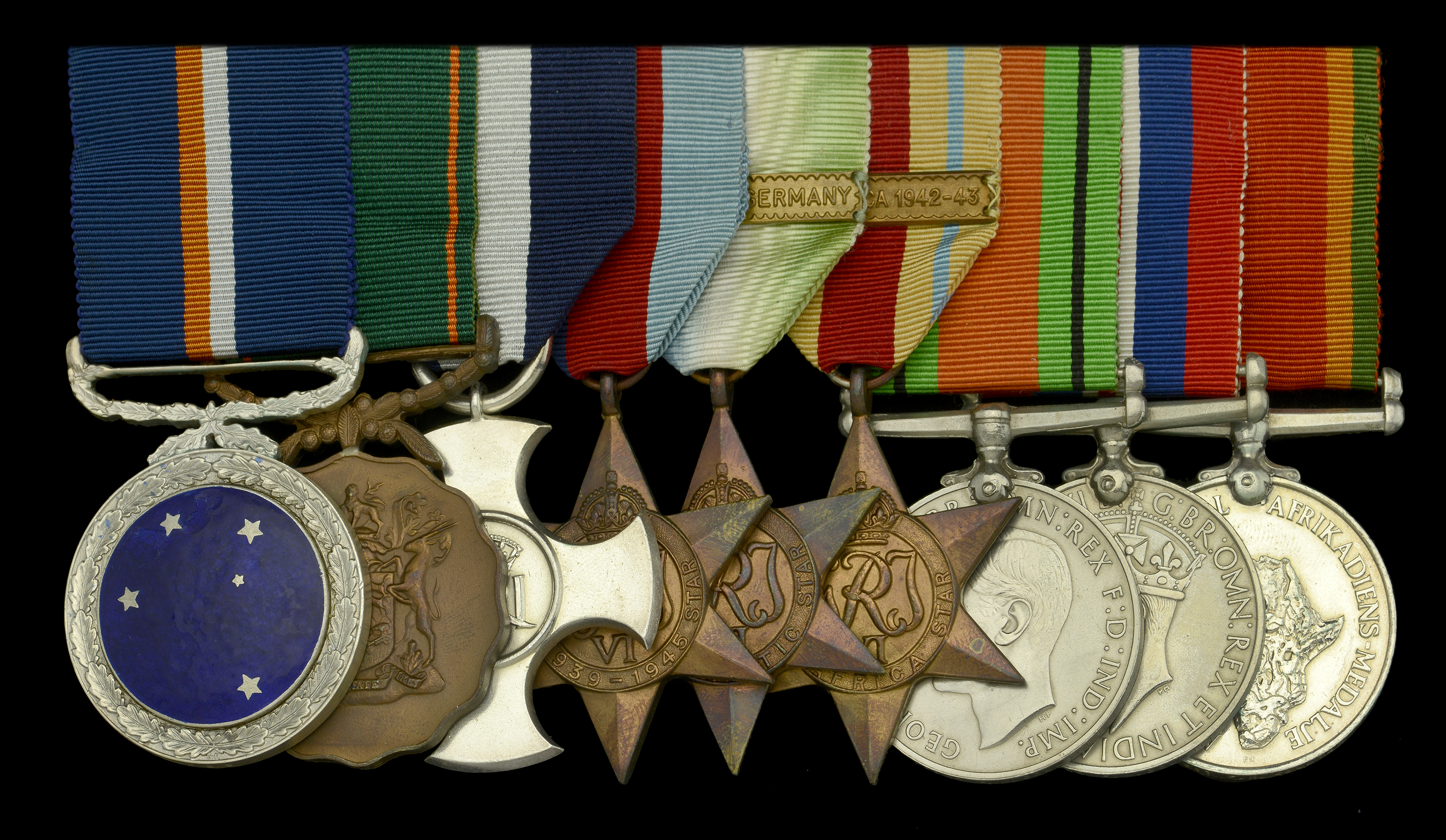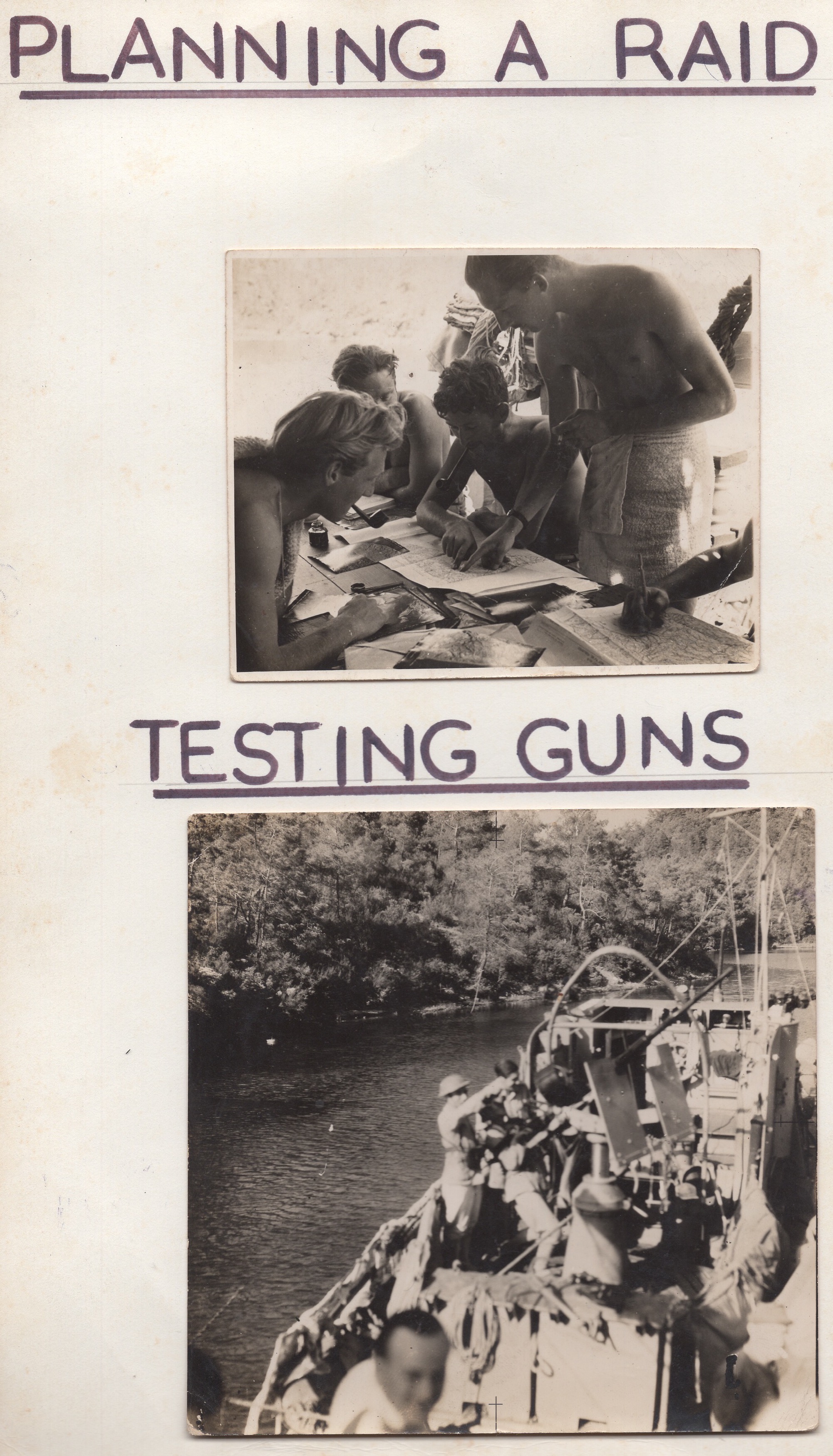The rare Second War clandestine operations D.S.C. group of nine awarded to Colonel F. N. Coulter, South African Defence Force, late South African Naval Force, attached Royal Navy; as captain of an H.D.M.L. in the secretive ‘Levant Schooner Flotilla’ he participated in more than 150 special forces operations in the Greek Islands in 1943-45, his ‘passengers’ including Anders Lassen, V.C. and Jellicoe of the S.B.S. Republic of South Africa, Southern Cross Medal, the edge officially numbered ‘339’; S.A.D.F. Good Service Medal, bronze, the edge officially numbered ‘3262’; Great Britain, Distinguished Service Cross, G.VI.R., the reverse officially dated ‘1945’ and hallmarked London 1945; 1939-45 Star; Atlantic Star, 1 clasp, France and Germany; Africa Star, 1 clasp, North Africa 1942-43; Defence and War Medals 1939-45; Africa Service Medal 1939-45, these last six all officially impressed (67617 F. N. Coulter), mounted as worn, good very fine (9) £5,000-£7,000 --- Importation Duty This lot is subject to importation duty of 5% on the hammer price unless exported outside the UK --- --- Provenance: Dix Noonan Webb, September 2003. Only two awards of the D.S.C. and three awards of the D.S.M. are believed to have been gazetted for services in Harbour Defence Motor Launches in the Aegean. D.S.C. London Gazette 14 August 1945: ‘For distinguished services, efficiency and zeal in H.M. Ships … in the clearance of the Aegean and the relief of Greece during the period 1944-1945.’ Frank Norris Coulter was born at Germiston in the Transvaal in November 1915 and entered the South African Naval Force (V.) as an Ordinary Seaman at Durban in June 1940. Commissioned as a Temporary Sub Lieutenant, R.N.V.R in October 1941, after attending the training establishment King Alfred at Hove in England, he was seconded for services with the Royal Navy in the following year. Following regular seagoing appointments in the minesweeper H.M.S. Speedwell and the asdic trawler Lady Hogarth, he joined the 119th Harbour Defence Motor Launch (H.D.M.L.) Flotilla in the summer of 1943, the commencement of his journey to employment in the clandestine world of the ‘Levant Schooner Flotilla’ (a.k.a. the Anglo-Hellenic Schooner Flotilla). Established in May 1943, the Flotilla was based at Mosquito II, Beirut, its primary task being to insert and collect elements of the S.B.S. and S.A.S., and other undercover units, as they carried out a busy agenda of daring raids and reconnaissance work on enemy-held islands in the Aegean. According to accompanying research, including copies of Coulter’s post-war operational notes, he participated in no fewer than 170 landings or pick ups between 1943-45, the whole in specially adapted 75-foot, wooden-hulled H.D.M.Ls 1028 and 1283. Crewed by two officers, two Petty Officers and around 15 ratings, their standard armament comprised a 40mm. Bofors, twin-Vickers, a 20mm. Oerlikon and eight depth charges. Their ‘cargo’ varied in size from a single operative to as many as 70 raiders, often raiders of the famous kind, Coulter’s notes including mention of an Anders Lassen drop-off on Samos, and trips with Major George Jellicoe to Metylini and Patmos. They also include his account of an operation to Piscopi, in which Major ‘Jock’ Lapraik and four raiders were landed to sabotage a runway being used by a German Fieseler Stork aircraft. However, their handiwork produced no results because the explosives they laid were stolen by a local Greek fisherman to bolster the size of his catch! Coulter sometimes had to steer his H.D.M.L. through the channel between the Turkish coast and Kos - actually the site of the fictional ‘Guns of Navarone’ - a passage that inevitably attracted the attention of the trigger-happy Turks. On one occasion their fire damaged the starboard side of H.D.M.L. 1283, penetrating the Coxswain’s quarters, but, as a result ‘of lots of luck, the rum ration contained in gallon earthenware jugs’ was not affected. Coulter’s secondment to the Royal Navy ended in November 1945 and he was finally released from full time service in June 1946. As late as 1966, however, he re-attested in Natal for national service in the Commandos, in the rank of Captain, and assumed command of the Highway Commando with the rank of Commandant in the following year. Awarded the Southern Cross Medal and advanced to Chief Commandant in 1968, he became a substantive Colonel in 1972 and was awarded his S.A.D.F. Good Service Medal in 1979, the year of his retirement. His also retained his interest in matters nautical, qualifying for his Master’s Certificate for ships of 100-tons or more in 1975, and serving as an Executive Member of the Durban Harbour Defence Committee from 1976-79. Sold with a quantity of original documentation, including Admiralty letter of notification for the award of his D.S.C., dated 22 August 1945, and investiture invitation to Government House, Pretoria, dated 14 November 1947; award certificates for his Southern Cross Medal and S.A.D.F. Good Service Medal, dated 1 November 1968 and 15 June 1979 respectively; Greek commemorative Campaign Star 1941-45 (Sea Operations); King Alfred passing out certificate, dated 23 October 1941; ship’s service ‘flimsies’ for the Speedwell and Lady Hogarth and a fine series of wartime photographs of the Levant Schooner Flotillla’s H.D.M.Ls at work in the Aegean.









